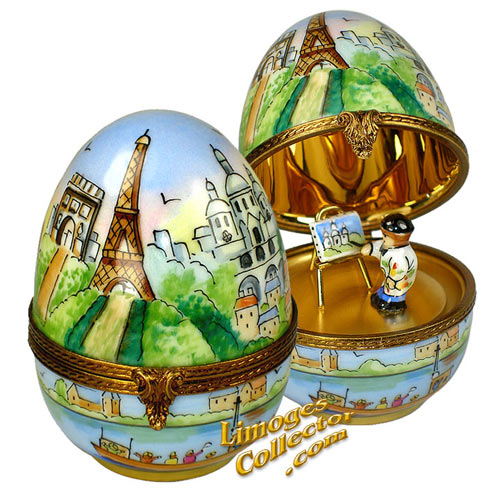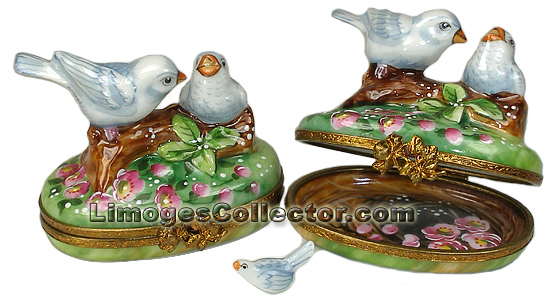
A Brief History of Limoges and Artistry of Limoges Boxes
|
Although today Limoges, France is most famous for its fine porcelain, the art-related history of Limoges began with champleve enamel work in the 12th century, during which time boxes and other decorative items were exquisitely crafted in intricate designs in enamel. This art form in Limoges developed into painted enamel and later into painted porcelain. The earliest examples of decorated porcelain were created in China in the second century B.C. In 1520, finished porcelain products were first imported to Europe and by 1712 the manufacturing process was begun in Europe. But, due to the shortage of the key ingredient for fine porcelain - "Kaolin" (white clay) - fine production of pure white porcelain was not yet possible in the west. In 1768, a very large deposit of the finest Kaolin in Europe was discovered near the town of Limoges, France. Limoges was an established trading and manufacturing center in the region. The abundant forests provided wood for the porcelain firing kilns and the Vienne river supplied plentiful water and transportation. These key factors as well as the availability of skilled local artisans, attracted designers and entrepreneurs from throughout Europe who established their individual manufacturing workshops "ateliers" in Limoges. Some of these ateliers became world famous trademarks which are revered to this day. Today, Limoges porcelain boxes are manufactured in the same manner in small workshops and ateliers in the Limoges region. To the modern collector, peint main Limoges boxes are enjoyed as beautiful objects of exquisite craftsmanship. Originally, however, they were used as snuffboxes, and considered almost an integral part of ones wardrobe, to be carried in ones pocket like a fancy cigarette case. When snuff-taking lost its popularity, the boxes lost their original purpose. In the early twentieth century, they were commonly used as pillboxes. They may still be used for such purposes. Today, Limoges boxes are cherished by collectors for their fabulous detail, creative designs and sophistication. The artistry of Limoges boxes evoke the same type of popular interest today as when they were first created in the 1700s. To learn more about Limoges boxes, see "What Is A Limoges Box? - Collecting Limoges Boxes 101" and "Limoges Boxes Historically Collected by European Royalty"
How Limoges Boxes Are MadeThe making of a Limoges box is an extremely labor-intensive art form and technique that has been preserved through time for the past 200 years. From making the original mold, mixing the kaolin paste and the various steps delineated below, the only aspect that has changed is the addition of electricity and gas that is now used to power the kilns for firing porcelain. The first step of making a Limoges box is a plaster mold. The desired shape is hand carved from a hard kaolin paste (clay) and is used as the model for the Limoges. The size of the model is slightly larger, taking into consideration the shrinkage of the final shape. The model shape is then used to create a plaster mold to be used to create each Limoges box.
The key ingredients for fine Limoges porcelain are: Kaolin (the basic white clay), feldspar (which is necessary for translucency) and quartz (for hardness and durability). These ingredients are mixed with water to make a soft paste and then sculpted or cast in molds. The kaolin paste solution is poured into the mold, enabling the absorption of excess water. When partially dried, the form is removed from the mold, sponged and dusted to remove any excess particles. While the kaolin form is still damp, small pieces (such as a ball for the dog) can be joined, using the kaolin paste as glue. The piece is sponged with cold water again to ensure it is in flawless condition. The kaolin then receives its first firing at a relatively low temperature of about 900 degrees to dry and partially harden. At this stage, the porcelain is called "Bisquit", a white matte form which is porous. The Limoges is then glazed by dipping each piece in a bath of liquid glaze and fired again at a high temperature of about 1400 degrees. During this firing process, the porcelain shrink about 15%, which is the reason for the slight variation in size and shape of each piece. The top and the bottom portions of a Limoges box are fired together to avoid distortion and to be a perfect fit. Through this firing, the stone particles actually become fused together and the surface coating dissolves into a permanent bond, resulting in a translucent, shiny, pure white, smooth porcelain. The porcelain shape is now ready to be hand-painted through a lengthy and multi-level process. Hand-painting a miniature porcelain Limoges box takes years of training and experience.
A master artist begins to carry out his or her exquisite and exceptional hand-painting. Adhering to the 200 year old process, the artist mixes the paint in powder form with special oils to achieve the desired shade of color. With a steady hand and an artistic flair, the design is then applied to the Limoges, one color at-a-time. With each color applied, the Limoges receives a firing at a different temperature (between 800 to 1200 degrees). The temperature of each firing depends on the paint and the color as different paints require different firing temperatures. This is quite a lengthy process as with each firing the porcelain has to completely cool before the next paint is added. Each brushstroke makes the Limoges box a unique art piece. After the decoration and firing treatment of the porcelain is completed, the boxes are ready to be hinged. The hinging process is in itself an art and the multi-level process is performed by expert craftsmen. The brass or copper mounting is cut by hand, measured for size around each piece of porcelain, brazed in very high temperature to form the exact shape of the piece. The hinges are then placed on a ring (to retain their fitting order) and immersed into acid for a few hours to develop a patina. The hinges are then fitted by hand around the edge of each piece (exactly in order - as each piece has a unique shape) for a perfect fit and the two sides of the box are attached with a hinge. A decorative clasp is then brazed to the front of the Limoges box. The end result is an exquisite work of art with magnificent detailed hand-painting and shiny glaze, ready for your enjoyment! Each Limoges box is an heirloom art piece, to be passed through the generations, allowing the work of the extra ordinary artists and craftsmen from Limoges to enchant our hearts.
|








